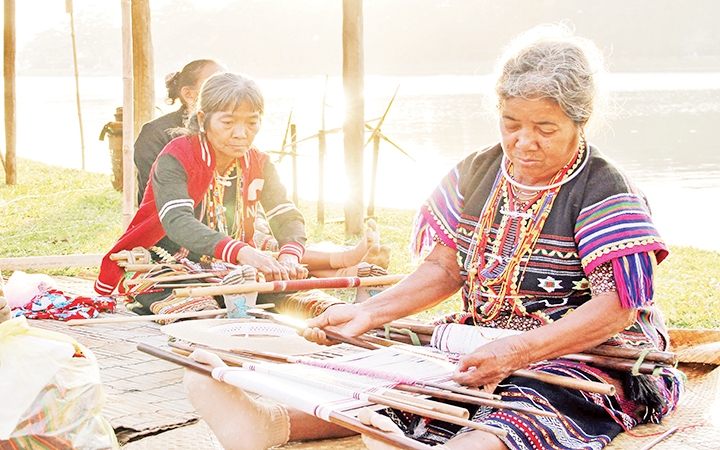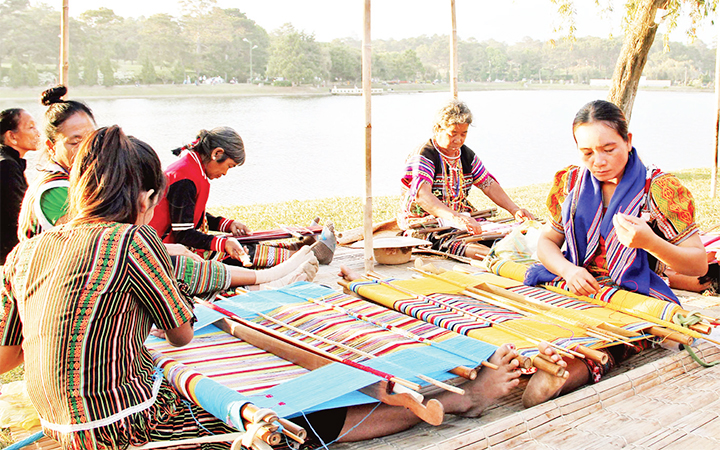During his childhood, Nhan Dan people’s journalist Uong Thai Bieu, used to listen to his grandmother singing folk songs while she was working on the loom. After years living far from his hometown, the dear image of his beloved grandmother has still been alive in his memory.

Elders in Buon Go village, Cat Tien district, Lam Dong province weaving brocade (Photo: NDO/Uong Thai Bieu)
During his numerous working trips to localities throughout the Central Highlands, he encountered similar images when watching older local ethnic women weaving brocade. In his notes below, Bieu told readers about the ethnic women in the Central Highlands, who have worked to preserve the quintessence of their traditional brocade.
I visited a village of the Da ethnic people, in Da The district, Lam Dong province, on the last days of last year. In Da Yarang village, many women were busy with completing the final steps in the making New year's costumes, which were made as orders from the S'tieng ethnic people in Binh Phuoc province, and the K’Ho ethnic people in Lam Dong’s Di Linh district.
As spring is the season of festivals and weddings, during which people dress in their most beautiful outfits, brocade artisans in Da Yarang village received many orders.
The Ma ethnic people are very proud that their brocade is famous in ethnic minority communities. Sitting by the loom, next to his daughter Ka Mam, elder K'Gon said that Ma ethnic girls learn about brocade making and weaving at a very young age, from their mothers and grandmothers.
After his wife passed away, K’Gon told his daughter Ka Mam, that no matter how hard the work is, she has to preserve the craft as a way to preserve family memories, and safeguard the identity for the Ma ethnic people.
Ka Mam is a skilful weaver who masters all the popular weaving patterns. She told me that when she was 12, her mother taught her every single step in the brocade making process, from picking cotton, spinning the cotton from seeds, weaving, and creating patterns on brocade. She also learnt how to dye cloth from natural colours, leaves, and fruits, such as turmeric, melaleuca leaves, and charcoal.
Pieces of brocades completed by Ka Mam, feature vivid and shimmering patterns, including water waves, people, animals, daily utensils and natural landscapes of mountains, the moon, rice mills, and banyan trees.
There are many other ethnic women in Lam Dong province who have a passion for the craft of brocade weaving. They included 65-year-old Ka Ra, a Ma ethnic woman who has more than 50 years working experience with the loom; 42-year-old Ka Rap, who learnt weaving since she was 14, both living in Da Nghich village in Bao Loc city; and artisans Ka Uong and Ka Tuyn in B'neur village, Lac Duong District, who have dedicatedly passed down the craft of brocade weaving, to the younger generations, despite their old age.
According to 80-year-old artisan Ka Glong in Dung K'Noh commune, Lac Duong district, while the Ma people use white as the major colour for their brocade, her K’Ho people, prefer dark colours such as blue, red, and black.

Ma ethnic women weaving brocade (Photo: NDO/Uong Thai Bieu)
Like the Ma’s, K’Ho brocade is also made from raw materials of cotton grown in the fields. For dyeing, they use turmeric to create yellow, k'ri (grape) seeds to make orange, bark of indigenous ‘lot’ tree to make red, and ‘drum’ leaves to create green. Glong revealed that to keep the colour stronger, locals add shell powder and ash of banana bulb to the dye water.
The colours of brocade, which represent the colours of the mountains and the forest, have a strong attachment to the life of the Central Highlanders. Brocade is an indispensable offering at weddings, when the bride offers a piece of brocade, which she made herself, to the family of the groom. That’s why brocade weaving is a must-have skill, for every ethnic girl in the region.
Although some people have concerns about the marketability of brocade in today’s life, I am optimistic about the vitality of brocade, the eternal value of a handmade product conveying the soul of the mountains and forests. Brocade has still been well consumed and appreciated in villages throughout Central Highlanders, and local artisans still receive regular orders from brocade enthusiasts. The vitality of brocade will continue brilliantly thriving and is kept alive by local communities.